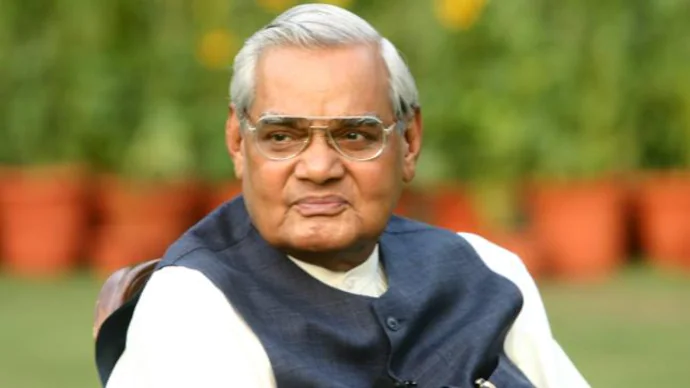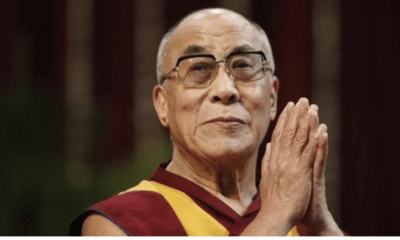
|
Getting your Trinity Audio player ready...
|
(The article was originally published by Chintan – India Foundation Blogs on December 25, 2022. Views expressed are personal.)
Atal Bihari Vajpayee – the very name invokes warm sentiments of goodwill across political and social spectrums. The world has seen many leaders. For some, leadership is a legacy handed down. They are born as leaders. Their greatness is drawn from their surnames. They are more like princelings than leaders. Some acquire greatness through their actions, their service and their projection. They remain leaders throughout their life time with the acquired greatness.
But there are some who command greatness by virtue of their very persona. Their very existence, and even their memory, radiates greatness. Their aura remains even when they are not there. They don’t just remain leaders, but become a phenomenon. Atalji was one such rare phenomenon in Indian politics.
Rarely do we come across leaders that command respect across both sides of the political firmament. Rarer are leaders who had no adversaries. But in Atalji, the country has seen a leader who can be described as “Ajatshatru” – ‘one without enemies’.
Not without reason that Atalji was also called the “Bhishma Pitamah” of Indian politics. Bhishma, the legendary warrior of the epic Mahabharata, was known not only for his war-craft but also for his great wisdom. Bhishma epitomised Raj Dharma. He proffered it, and practised it too. In Atalji, one saw the virtue of that Raj Dharma. Governance is not just a craft, that one can skillfully manage. It is a ‘Dharma’ – a moral code. Bhishma was the first to articulate it proficiently.
Thomas Hobbs – a 17th century British philosopher and the father of the social contract theory, proposed that the state is a product of a contract between the rulers and the ruled. But in Indian philosophy, the state was seen as an instrument to uphold Dharma. Out of Hobbs’ social contract theory emerged the present-day democratic system, which believed that “a society gets a government it deserves”.
But the Indian understanding of the statecraft was: “Yatha Raja Tatha Praja”. From Bhishma in Shanti Parv to Kautilya in Arth Shastra, insisted that “Raja Kalasya Karanam” – ‘King is responsible for the times’. In other words, it was believed that the rulers are responsible for moulding the society. In that sense, good governance is not limited to delivering goods to the people; it is also about shaping the future of a nation.
In the West, right from the time of the Greeks, state and society were seen as separate, and often antagonistic entities. But Kautilya in Arth Shastra erases that distinction and insists that a king is his kingdom only. It shouldn’t be understood as authoritarianism or dictatorship. Kautilya’s insistence was that the king had no identity apart from his people. “In the happiness of his people lies the happiness of the king”, exhorted Kautilya. That is the basis of Raj Dharma and Dharma Rajya.
Ancient Indian philosophers have talked about the concept of yogakshema – well-behaving and well-being of the people. That too was stated as the basis of good governance or Raj Dharma.
The Shukla Yajurveda (6.31) includes a prayer wherein a king prays: “let my subjects be satisfied, my herds be satisfied, my people be satisfied, let not my people be needy.”
Happiness was not understood as mere material development, but the pervasive greater sense of unity, security and peace.
In Shanti Parv as also in Artha Shastra, both Bhishma and Kautilya enumerate several qualities that are required for the ruler to uphold this Raj Dharma of bringing Yogakshema – all-round development of man and society.
Kautilya’s benchmarks for a true leader were daunting. He called for leaders who were Rajarshis.
आत्मज्ञानं समारंभस्तितिक्षा धर्मनित्यता यमर्थान्नापकर्षन्ति स वै राजर्शि: उच्यते |
They who are not overwhelmed by the challenges of life owing to their knowledge, persistence, patience, and virtue are the wise, deserving the position of leadership.
निषेवते प्रशस्तानि निन्दितानि न सेवते अनास्तिक: श्रद्दधा एतद् राजर्शिन: लक्षणम् |
The wise are those who adhere to their duties, who stand by their words, who praise the deserving, criticize the undeserving, who are untouched by selfish interest and who are revered for their virtues. Such people deserve the position of leadership.
क्रोधो हर्षश्च दर्पश्च ह्रीस्तम्भो मान्यमानिता यमर्थान्नापकर्षन्ति स वै राजर्शि: उच्यते |
That person who overwhelms his anger, joy, sorrow, and pride, who has no false modesty, neither confusion nor vanity, who can stay equanimous in mind at all times, is undoubtedly a wise deserving position for leadership.
As we start judging leaders by those values, Atalji obviously stands out heads and shoulders above many others.
Atal Democracy:
Jawaharlal Nehru passionately declared that India would be a democracy after independence. But it was only Vajpayee who made it a true democracy by building the much-needed second national pole in the country’s politics.
When Nehru announced that India shall adopt a democratic model of government, Gandhi wrote that he was not well-versed in those Western ideologies, but understood that democracy for independent India should be the Ram Rajya. “By Ram Rajya, I do not mean a theocracy. It will be a state where the weakest shall have as much power as the strongest”, he wrote.
Deen Dayal Upadhyay, the ideologue-leader of Bharatiya Jan Sangh, insisted that for a country like India, democracy should mean consensus building.
Atalji sought to emulate these leaders in delivering his Raj Dharma. His positivity, transparency and openness to ideas had allowed him to understand and assimilate diverse strands of political opinion. “Indian democracy’s greatest strength is that we have always put the nation above politics”, Vajpayee once insisted.
Power was never a big attraction for him. People still remember his address in the parliament while relinquishing power in 1996 after 13 days of the government. “Parties will come and go; governments will be made and unmade; but this nation should remain strong and its democracy should remain flourishing” – That was Vajpayee.
It was this detachment from power and dignified engagement with diverse shades of opinion that had helped him perform a herculean feat of forging a 23-party government and successfully running it for full five years.
As Prime Minister, Vajpayee delivered all-round development in the country. Many people-centric initiatives took shape during his tenure as Prime Minister. Those transformational initiatives include the Kisan Credit Card, Golden Quadrilateral, Pradhan Mantri Gram Sadak Yojna, the National Rural Health programme, interlinking of rivers, Sarva Shiksha Abhiyan, a separate ministry for tribal affairs, a revolutionary telecom policy and many more.
A shining example of his successful consensus building was the formation of three new states-Chhattisgarh, Jharkhand and Uttarakhand in 2000 in a peaceful manner.
Vajpayee Doctrine:
India had eleven prime ministers before Vajpayee. But only two were credited with having a doctrinal approach to governance. Nehru had Panchsheel as the sheet-anchor of his foreign policy. Indira Gandhi too was credited with a doctrine that allowed interference in the neighbourhood for India’s greater security. Apart from these two, the only other prime minister credited with a doctrinal approach to governance was Atal Bihari Vajpayee. Doctrines are the foundational principles which guide the policies of future governments.
The Vajpayee Doctrine saw the nuclearisation of India’s security as an imperative. However, that doctrine also emphasised that those “nuclear weapons were meant purely as a deterrent against nuclear adventure by an adversary.” “No first use”, announced by Vajpayee in the wake of the nuclear tests in 1998 continues to guide India’s nuclear policy.
On the neighbourhood too Atalji’s views were doctrinal. “We can change our friends but not neighbours”, he once told the Indian Parliament. That belief took him to Lahore by bus, and allowed Musharraf a sojourn to Agra after his serious misadventures like the Kargil War and the Parliament attack. But Atalji was also categorical that “the overwhelming public sentiment in India was that no meaningful dialogue can be held with Pakistan until it abandons the use of terrorism as an instrument of its foreign policy.” Musharraf was sent back empty-handed.
In resolving the complex problem of Kashmir, the Vajpayee doctrine enunciated the principle of “insaniyat, jamhuriyat and Kashmiriyat” (humanity, peace, and the sanctity of Kashmiri people). In different forms and shades, that continues to guide Indian policy in the troubled region to this day.
Like any other public leader, Vajpayee too endured criticism. His doctrine was subjected to harsh scrutiny. But in the end the Swayamsevak in him, which he always claimed himself to be, always guided his actions. And the poet in him always rescued him.



